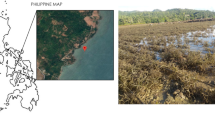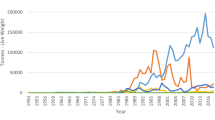Abstract
The occurrence of encrusting colonies of the hydroid Obelia geniculata on farmed Saccharina japonica was examined between December 2007 and July 2008 at a Saccharina farm at Wando on the southwestern coast of Korea. The growth stages of S. japonica can be divided into two phases: an active growth phase from February to the end of May and a decay phase from June to July. There was a significant increase in the level of incrustation by colonies on fronds (measured as the percentage of fronds with encrusting colonies) between February and July (p < 0.05). The encrusting colonies occurred first on the upper part of the frond in February and progressed to the basal part in July. The abundance of encrusting colonies in relation to the growth phase on farms over time was limited by the harvest of the seaweed crop at the end of the cultivation period in July. The stipes and holdfasts of fronds showed no signs of infestation at any time during the cultivation period. The extent of the infestation appeared to be related to a combination of factors. These could be reduced physiological activity and subsequent tissue aging that occurred simultaneously in the sporophytic life phase of Saccharina frond, and a rapid increase in reproduction and growth of O. geniculata coinciding with rising seawater temperature.





Similar content being viewed by others
References
Boero F, Bouillon J (1993) Zoogeography and life cycles pattern of Mediterranean Hydromedusae (Cnidaria). Biol J Linn Soc 48:239–266
Boero F, Bucci C, Colucci AMR, Gravili C, Stabili L (2007) Obelia (Cnidaria, Hydrozoa, Campanulariidae): a microphagous, filter-feeding medusa. Mar Ecol 28:178–183
Chang JW, Chung DY (1971) Studies on the culture of Laminaria. (2) on the tide over the summer of cultivated Laminaria religiosa Miyabe in warm water area. Bull Fish Res Dev Agency 8:31–43
Choe BL, Kim HS (1988) On the classification and distribution of archeogastropods from Korean waters. Korean J Syst Zool Spec Issue 2:135–198
Fraschetti S, Terlizzi A, Bevilacqua S, Boero F (2006) The distribution of hydroids (Cnidaria, Hydrozoa) from micro- to macro-scale: spatial patterns on habitat-forming algae. J Exp Mar Biol Ecol 339:148–158
Hasegawa Y (1962) An ecological study of Laminaria angustata Kjellman on the coast of Hidaka province, Hokkaido. Bull Hokkaido Fish Res Lab 24:116–138
Hasegawa Y (1976) Progress of Laminaria culture in Japan. J Fish Res Board Can 33:1002–1006
Kang JW, Ko NP (1977) Seaweed Aquaculture. Taehwa, Busan, pp 237–258
Kawashima S (1984) Kombu cultivation in Japan for human foodstuff. Jap J Phycol 32:379–394
Lambert WJ (1991) Coexistence of hydroid-eating nudibranchs: recruitment and non-equilibrial patterns of occurrence. J Mollusc Stud 57:35–47
Lim HS, Choi JW, Je JG, Lee JH (1992) Distribution pattern of macrozoobenthos at the farming ground in the western part of Chinhae Bay, Korea. Bull Korean Fish Soc 25:115–132
Mairh OP, Ohno M, Matsuoka M (1991) Culture of brown alga Laminaria japonica (Phaeophyta, Laminariales) in warm waters of Shikoku, Japan. Indian J Mar Sci 20:55–60
Matsuoka M, Ohno M, Akizuki T (1991) Growth of transplanted Laminaria japonica Areschoug in the culture ground of the Naruto Straits in temperate waters. Suisan Zoshoku 39:267–271
MIFAFF (2011) Statistic database for fishery production survey. Ministry for Food, Agriculture, Forestry and Fisheries, Korea. Available at http://fs.fips.go.kr/main.jsp. Accessed 11 Aug 2011
Morita T, Jurashima A, Maegawa M (2003) Temperature requirements for the growth of young sporophytes of Undaria pinnatifida and Undaria undarioides (Laminariales, Phaeophyceae). Phycol Res 51:266–270
Nakawaki T, Agatsuma Y, Taniguchi K (2001) Annual life cycle and productivity of the Laminaria japonica population in Onagawa Bay, northeastern Honshu, Japan. Suisan Zoshoku 49:439–444
Panteleeva NN (1999) Obelia longissima (Pallas, 1766) and Obelia geniculata (L., 1758) (Hydrozoa, Thecaphora, Campanulariidae) in the Barents Sea. Morphology, distribution, ecology and special life history features. Zoosyst Rossica Suppl 1:51–65
Rho BJ (1977) Illustrated flora and fauna of Korea. Vol 20 Porifera, Hydrozoa and Ascidiacea. Ministry of Education, 470 pp
Russell G (1983a) Formation of an ectocarpoid epiflora on blades of Laminaria digitata. Mar Ecol Prog Ser 11:181–187
Russell G (1983b) Parallel growth patterns in algal epiphytes and Laminaria blades. Mar Ecol Prog Ser 13:303–304
Russell G, Veltkamp J (1984) Epiphyte survival in skin-shedding macrophytes. Mar Ecol Prog Ser 18:149–153
Sanbonsuga Y (1984) Studies of the growth of forced Laminaria. Bull Hokkaido Reg Fish Res Lab 49:1–78
Slobodov SA, Marfenin NN (2004) Reproduction of the colonial hydroid Obelia geniculata (L., 1758) (Cnidaria, Hydrozoa) in the White Sea. Hydrobiologia 530/531:383–388
Sohn CH, Kain (Jones) JM (1989) Undaria, Laminaria and Enteromorpha cultivation in Korea. In: Kain (Jones) JM, Andrews JW, McGregor JB (eds) Proceedings of the 2nd workshop of COST 48 subgroup 1. Port Erin, Isle of Man, British Isles, pp 42–45.
Song JI, Lee IS, Won JH (1995) An ecological study on the marine invertebrates in Onsan Bay, Korea. Korean J Environ Biol 13:131–151
Suzuki S, Furuya K, Takeuchi I (2006) Growth and annual production of the brown alga Laminaria japonica (Phaeophyta, Laminariales) introduced into the Uwa Sea in southern Japan. J Exp Mar Biol Ecol 339:15–29
Tokida J, Yama T (1960) On organisms growing on the Laminariales plants (I). Bull Jap Soc Phycol 8:15–21
Watson JE (1992) The hydroid community of Amphibolis seagrasses in south-eastern and south-western Australia. Scientia Mar 56:217–227
Whittick A (1983) Spatial and temporal distribution of dominant epiphytes on the stipes of Laminaria hyperborea (Gunn.) Fosl. (Phaeophyta: Laminariales) in S. E. Scotland. J Exp Mar Biol Ecol 73:1–10
Acknowledgments
This work was supported by Priority Research Centers Program through the National Research Foundation of Korea (NRF) funded by the Ministry of Education, Science and Technology (2009-0093828) and National Fisheries Research & Development Institute (RP-2011-AQ-088). We thank Dr. Philip Heath (NIWA, New Zealand) for reviewing the English. We also thank two anonymous reviewers for helpful comments.
Author information
Authors and Affiliations
Corresponding author
Rights and permissions
About this article
Cite this article
Park, C.S., Hwang, E.K. Seasonality of epiphytic development of the hydroid Obelia geniculata on cultivated Saccharina japonica (Laminariaceae, Phaeophyta) in Korea. J Appl Phycol 24, 433–439 (2012). https://doi.org/10.1007/s10811-011-9755-3
Received:
Revised:
Accepted:
Published:
Issue Date:
DOI: https://doi.org/10.1007/s10811-011-9755-3




